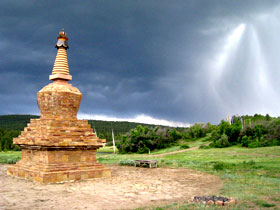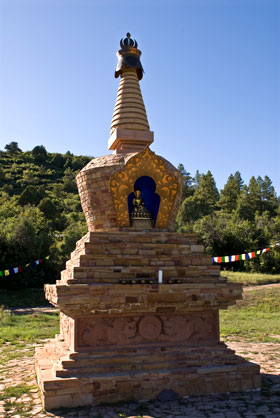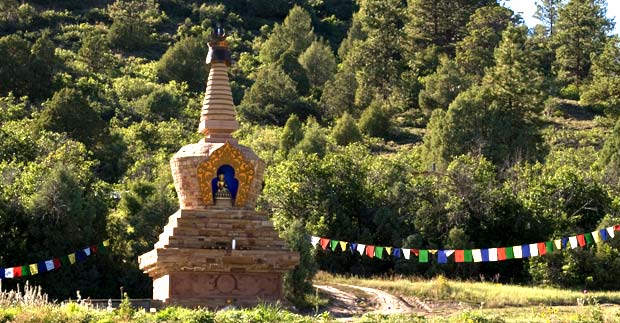
A Stupa is something like a spiritual generator. If the relics contained within it arepowerful and the intention expressed during its creation are pure, the impact of a Stupa can be important for the entire surrounding country, promoting harmony, prosperity, longevity, good health, and peace. It also helps to subdue fear, corruption and pollution. When we see a Stupa in the West it is often viewed as a beautiful form of altar or shrine from the East, but a Stupa, or Choten in Tibetan, exists on many different levels, and most are not perceived by the five senses. The outer form is a symbol for the real energy of the Stupa.
The real Stupa demonstrates the mind of the Buddha, and the path to enlightenment. The Stupa brings together absolute and relative truth. In its absolute reality the Stupa symbolizes the indestructible, the unconditioned; what is beyond words and concepts, what is Buddha mind.
Shortly before his paranirvana, the Buddha instructed his students to cremate his body and place his ashes and the remains of his bones in a Stupa. People could visit the Stupa, venerate it, and renew their connection to his teachings. Since that time, hundreds of thousands of Stupas have been built, enshrining the relics of the Buddha and of many other enlightened teachers. “Stupa” is a Sanskrit word which means “to heap” or “to pile up,” and refers to the mound-like shape of the earliest Stupas. The Tibetan word for Stupa is Choten or “receptacle for offerings.”
 The building of a Stupa will ground and sustain the spiritual energy of the Tibetan masters on the Tara Mandala land. It is like inviting a Buddha to dwell on the land. “Building a Stupa,” said the Dzogchen master, Tulku Urgyen, “is cause for the greatest accumulation of merit (positive energy) possible.”
The building of a Stupa will ground and sustain the spiritual energy of the Tibetan masters on the Tara Mandala land. It is like inviting a Buddha to dwell on the land. “Building a Stupa,” said the Dzogchen master, Tulku Urgyen, “is cause for the greatest accumulation of merit (positive energy) possible.”
From the beginning we planned to build several Stupas on the land. Then the night before the Mandarava retreat began, early on the morning of May 5, 1995, I had a dream. In the dream I heard a voice saying, “You must build a Stupa dedicated to Nyala Padma Duddul.” When I started to go back to deep sleep, the command was repeated, “Don’t forget: Build a Stupa dedicated to Nyala Padma Duddul.” This jerked me out of my sleep momentarily and I made a note of my dream in my mind and started to fall asleep again. The instructions were repeated again several times each time more insistently, until finally I was unable to sleep any longer.
I woke up with the instructions and the placement of the Stupa, along with the size and the shape. The place was in a field just before you go up the hill to a yurt.
I felt the dream had to be followed by action due to its strange insistent quality and the fact that the placement was not where my logic had placed it, but in a place I had never even considered. I didn’t know a great deal about Nyala Padma Duddul. So I decided to ask Namkhai Norbu Rinpoche and to look up Nyala Padma Duddul.
Researching Nyala Padma Duddul, I discovered he was the root master of Ayu Khandro, Chang Chub Dorje, and Adzom Drukpa, all root teachers of Namkhai Norbu Rinpoche; in other words, the root lineage for Tara Mandala. It made perfect sense. He was especially known for the terma of Amitayus yabyum, which he discovered. It was the practice that Guru Padma Sambhava and Mandarava were doing when they achieved the siddhi of long life at the cave of Maratika in Nepal. It was also the practice that Namkhai Norbu Rinpoche was doing at Maratika when he revealed the terma of Mandarava, “The Sphere of the Vital Essence of the Vajra.”
In the morning at the retreat I told the group the dream and decided it would be auspicious to start that day. So during the lunch break, we moved some stones to the place indicated in the dream. As the activity to move the stones began, a circular rainbow formed around the sun with a light red glow extending from the rainbow to the sun (called a sun dog). A late snow squall created beautiful flakes in the pinkish light from the sun.
 At the end of the retreat, I spoke to Namkhai Norbu Rinpoche about the Stupa, and he said that it would act as a support for the lineage of Nyala Padma Duddul and the Dzogchen teachings. In the meantime, Dugu Choegyal Rinpoche had written him a letter expressing the necessity for his students to build a Stupa for his long life. With this and other indications put together, I contacted Choegyal Rinpoche and he very kindly agreed to be at Tara Mandala from May 15 to June 13 helping with the Stupa and teachings as well. He will be teaching a retreat on “Mahamudra Dohas of the Dakinis” from May 24 to June 2. Dohas are poems of realization; spontaneous, logic-busting songs of layered meaning, something similar to haiku, koan’s and Rumi’s poetry.
At the end of the retreat, I spoke to Namkhai Norbu Rinpoche about the Stupa, and he said that it would act as a support for the lineage of Nyala Padma Duddul and the Dzogchen teachings. In the meantime, Dugu Choegyal Rinpoche had written him a letter expressing the necessity for his students to build a Stupa for his long life. With this and other indications put together, I contacted Choegyal Rinpoche and he very kindly agreed to be at Tara Mandala from May 15 to June 13 helping with the Stupa and teachings as well. He will be teaching a retreat on “Mahamudra Dohas of the Dakinis” from May 24 to June 2. Dohas are poems of realization; spontaneous, logic-busting songs of layered meaning, something similar to haiku, koan’s and Rumi’s poetry.
In October 1995, Namkhai Norbu Rinpoche gave me some very special relics for the Stupa along with his blessings for the work. We have also been given the tooth Drukpa Kagyu master, Apho Rinpoche, offered by Paul Kloppenburg, Tsultrim’s first husband.
Originally Published in the Tara Mandala Newsletter; Spring, 1996
Relics Installed in the Tara Mandala Stupa
18 Buddha Relics including a relic from Baudha Stupa recovered by Shakya Shri
Fingernails: Fingernails of Nyala Pema Duddul after he took rainbow body.
Bones: Bones of Jigme Lingpa, Dodrub Chen Rinpoche.
Hair: Hair of Jigme Lingpa, Guru Rinpoche, Le gi Wongmo Khadro (female guru of Guru Rinpoche), Khabje Tulku Orgyen Rinpoche (Urgyen Tsewan Chokdrup, 1920-1996).
Teeth: Large molar of Apho Rinpoche.
Robes: Cotton cloth that covered the body of Nyala Pema Duddul when he took rainbow body, Chan Chub Dorje, silk that covered the body of Adzom Drukpa when he died, clothes of Herka Lingpa (Khentse Chokyi Wangchuk), cloth from the body of Ayu Khadro, cloth from the body of Apho Rinpoche when he died.
Tsa Tsas: Adzom Drukpa’s tsa tsa of Guru Rinpoche made of Mendrub by himself, Chang tsa of Guru Rinpoche made by Apho Rinpoche.
Medicine: Medicine from the water that washed Apho Rinpoche’s body after death, from Vairocana, Udra Nyingpo, salt from the body of the 16th Karmapa, longlife pill from Ayu Khadro, mani rilbu from Tso Pema.
Sacred Pills: The flesh of Jigme Lingpa, mixed pill of many relics from Gangteng Tulku, mixed relics from Apho Rinpoche, 7th born brahmin pill, mendrub of Dudjom Rinpoche, 16th Karmapa mendrub, Dzogchen Dungwa Kunga Palden made when his body was washed at death, pill made from clay and the water that washed the Kangyur when completed, pills from 10 important masters including Chang Chub Dorje.
Sacred Places: Seed from the bodhi tree, Sindura from Mt. Kailash, Longchenpa’s Rahula Practice Soil, sand from Bodhgaya, sand from Lumbini (Buddha’s birthplace), sand from main shrine room Sarnath (where the Buddha first turned the wheel of the Dharma), sand from Kushinagar (paranirbana of the Buddha), sand from Guru Rinpoche’s cave, Parping, stone from Yeshe Tsogyal’s cave in Drigung Shoto Terdrom, earth from Lhalung Palden’s birthplace, pine nuts from Powo, stone from the sacred hot springs at Terdrom, earth from cave at Maratika where Namkhai Norbu Rinpoche revealed the Mandarava terma, rock from Maratika, relics from Mt. Kailash, Varjra Togini’s red soil: Terdrom, earth from Lotrsawa Marpa’s holy place, earth from Machig Lapdron’s cave, earth from the secret cave of Guru Rinpoche at Tso Pema.